Last Updated on March 15, 2022
The average vehicle is generally subject to a number of mechanical issues throughout its lifetime, many of which can be rather concerning to motorists. Of these mechanical issues, few are as troubling as those related to a vehicle’s brakes, which serve as the most significantly important of all automotive safety equipment.
While most envision a lack of stopping power as the most prominent of all brake-related issues, one can also find themselves faced with brakes that are stuck or seized. More specifically, a vehicle’s parking brake or emergency brake can freeze, leaving such safety equipment applied, despite efforts to the contrary.
In fact, parking brakes stick far more often than most would imagine, especially in relation to certain makes and models of vehicles. This presents quite the troubling scenario, in which one must determine exactly how to proceed.
Read on to learn more about the potential causes of a stuck parking brake, as well as what you should know if you were to face such a situation in the future.
See Also: 3 Reasons a Car Won’t Shift Out of Park
What is a Parking Brake?

A parking brake is an auxiliary braking mechanism, capable of preventing forward or aft movement of a vehicle, even when traditional hydraulic brakes are not applied.
In almost every case, a parking brake, or e-brake as it is often called, operates purely off of the principle of mechanical force. This eliminates the need for hydraulic or electrical input.
Parking brakes are almost always cable actuated by design, and are reliant upon the depression of a specialty pedal, or the sweep of a handbrake lever, depending upon the vehicle in question. An application of this type pulls a vehicle’s parking brake cable, thereby applying pressure to a tensioning device.
Pressure is released upon this brake mechanism by disengaging a vehicle’s parking brake pedal, or by lowering a handbrake lever back to its neutral position. Failing to do so before driving away will cause a vehicle’s emergency brakes to drag, often with dire consequences.
Types of Parking Brakes
There are several different types of parking brakes currently in service along today’s roadways. The exact type of parking brake that a vehicle comes equipped with varies by manufacturer, as well as by model.
The following are the most common types of parking brakes in use today.
Drum-Style Parking Brake
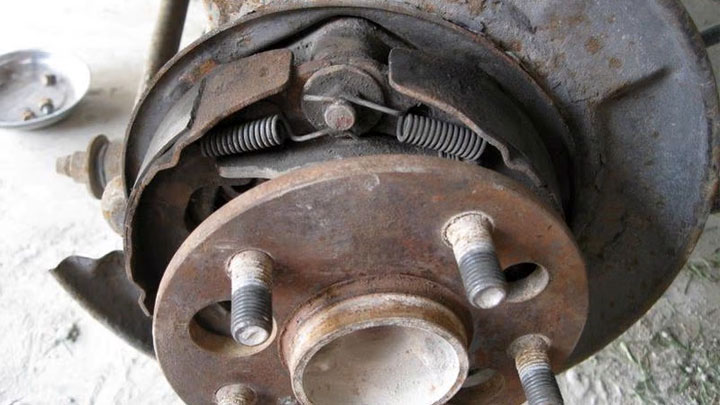
Vehicles equipped with drum brakes utilize a specialty cable-driven lever to engage the assembly’s brake shoes, wedging them against the inner diameter of the brake drum itself.
This occurs without any actuation of the assembly’s wheel cylinder, as is the case during typical hydraulic brake applications.
Disc/Drum Hybrid Parking Brake
Many vehicles featuring 4-wheel disc brakes now utilize a separate drum-style parking brake assembly, mounted within the hat of a rear brake rotor. This cable-driven assembly operates similarly to that utilized by standard drum brake-equipped vehicles.
When the parking brake cable is tensioned, internally-mounted brake shoes contact the interior surface of the rotor’s hat, thereby implying friction.
Modified Disc Parking Brake
A number of newer vehicles equipped with 4-wheel disc brakes feature a modified disc brake design, which uses a vehicle’s rear calipers as the source of the application.
Parking brakes of this variety rely upon the actuation of a cable-driven lever, to force a caliper’s brake piston outward. This is in direct contradiction to a service brake application, which is completed through the delivery of hydraulic force.
Electronic Parking Brake
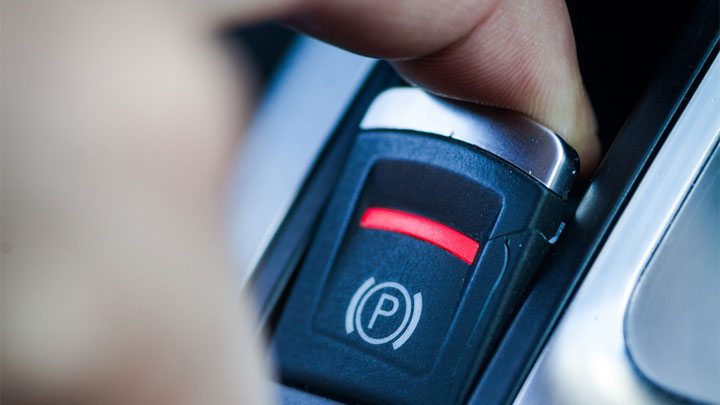
In recent years, a number of vehicles have begun to employ the use of electronically actuated parking brakes. This electronic mechanism is integrated into a vehicle’s rear brake calipers.
Upon application of a switch or button, an electric motor forces a brake caliper’s piston outward, thereby causing the corresponding brake pads to make contact with their rotor.
Causes of a Stuck Parking Brake
There are numerous conditions that can cause a vehicle’s parking brake to stick, each of which can prove equally as problematic in the moment. The following are several of the most common causes of a stuck parking brake.
#1 – Corrosion
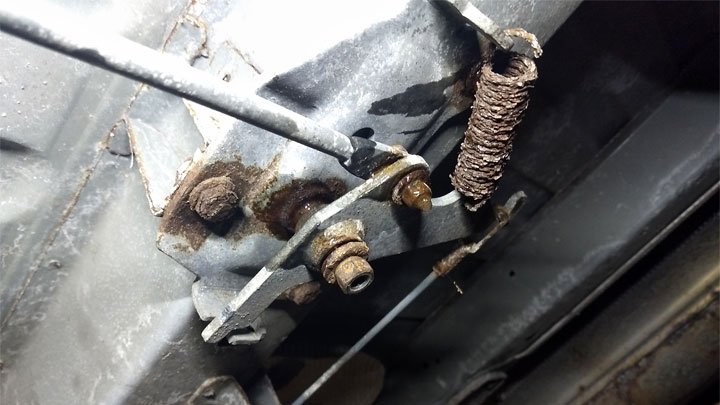
Corrosion is by far, the most common cause of a stuck parking brake. With time, a vehicle’s parking brake cable, mechanism, or linkage can fall victim to rust, thereby rendering it inoperable.
This is especially common in vehicles that have spent much of their time in northern climates, where the regular application of road salt is standard practice. These problems are only exacerbated if a vehicle’s parking brake is seldom used.
#2 – Freezing Weather

Extreme cold weather can cause many brake problems. In many northern climates, a vehicle’s parking brake can actually freeze in the applied position, if left set overnight, or for an extended period.
This is especially common if a vehicle has been driven in wet weather, directly before being parked with the emergency brake set. In such cases, one must find a way to thaw their frozen brake linkage, before proceeding.
#3 – Rigid Application
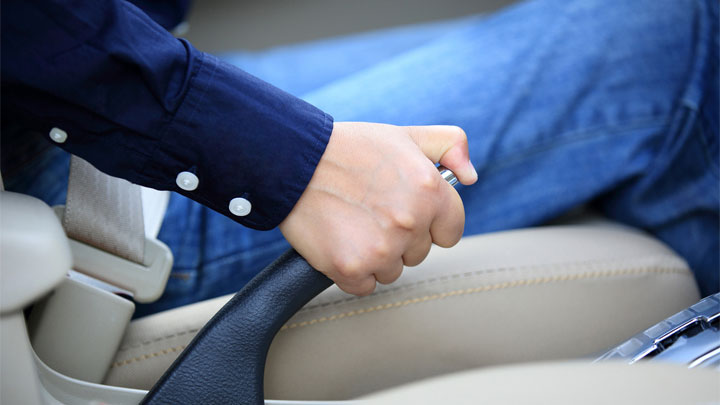
Believe it or not, it is actually possible to jam your parking brake, by using excessive force when setting it, either by a foot pedal or hand lever.
Only moderate force is required for a safe parking brake application. Anything in excess of this can cause a vehicle’s parking brake cable to stretch or can bind a parking brake’s terminal linkage, all of which can prove troublesome.
Read Also: 5 Causes of Brakes Locking Up While Driving
Can You Drive With a Stuck Parking Brake?

Driving with a stuck parking brake is never advised. This is due to the fact that the offending brake shoe or brake pad will continue to drag across its corresponding brake rotor or drum.
This constant friction will begin to cause heat build-up within seconds, even presenting the risk of fire. In many cases, a stuck parking brake will be accompanied by a burning smell and even a fair amount of smoke.
Attempting to drive with a stuck parking brake will also risk significant damage to a vehicle’s brake hardware. In addition to this, excessive wheel-end heat build-up, such as that generated by a stuck parking brake, can prove detrimental to hub and axle seals, even expediting failure in the most severe of cases.
In any event, a stuck parking brake should be taken seriously, and addressed immediately. If you do not feel up to the task of addressing your vehicle’s parking brake-related issues, a tow truck should be called, and repair should be scheduled at a qualified service center.
Can the Parking Brake Be Manually Disengaged?
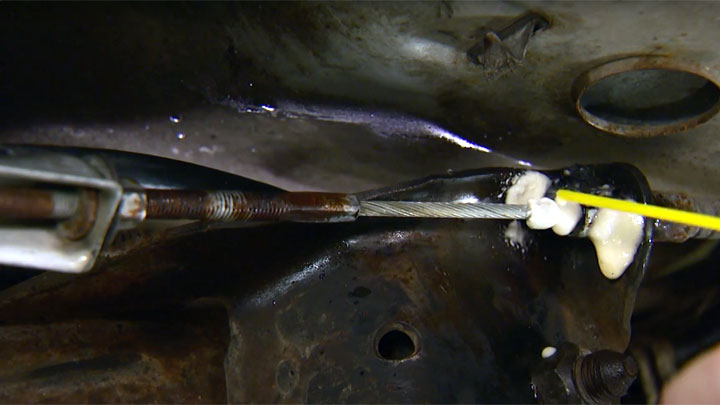
In a number of cases, a stuck parking brake can be manually disengaged, in order to facilitate further vehicle operation. However, doing so requires one to understand the manner in which their vehicle’s parking brake operates and the exact cause of their parking brake’s malfunction.
If a vehicle’s parking brake has become frozen, heat must be applied to free any binding that is discovered.
In many cases, simply allowing one’s vehicle to idle for a prolonged period, will create enough exhaust heat to remedy the situation at hand. However, this process can also be expedited by providing a little well directed heat from a hand held propane torch.
In the event that corrosion is to blame for parking brake related difficulties, the repeated application of a vehicle’s hydraulic brakes can often provide relief. However, intervention via mechanical means might be necessary.
In certain cases, several well-directed sprays of white lithium grease or penetrating oil, followed by the application of pressure to a vehicle’s brake cable can prove beneficial.
In the most extreme case, one might be required to attempt disengaging their vehicle’s e-brake by hand. This typically involves applying tension to a vehicle’s parking brake cable by hand, at or near the point at which two sections of parking brake cable adjoin, or where the parking brake itself meets its corresponding linkage.
This can be done by pulling upon the cable with a set of vice-grips while prying it from its retainer.

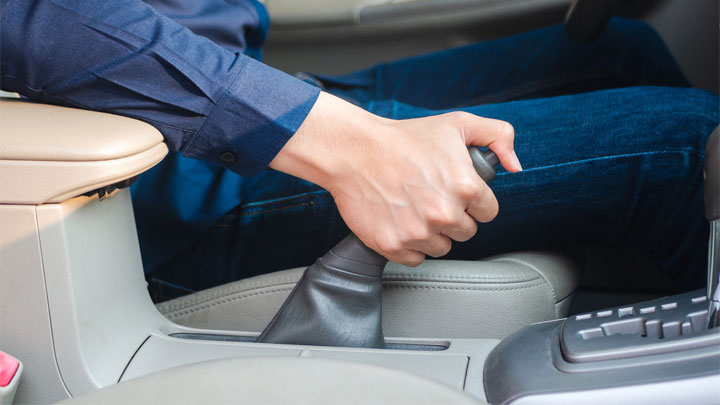


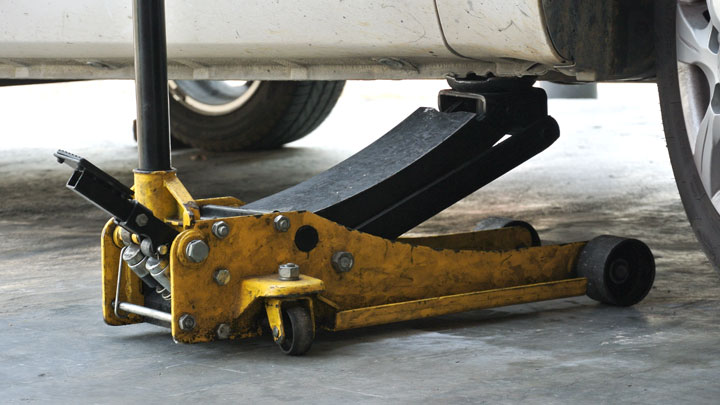
Y parking brake light comes onthe dash without me engaging the parking brake pedal. At different times out of the blue the light comes on I have to pull the emergency brake rrealease . It’s a really hard pull about the 3rd time the light finally goes off and the emergency brake pedal stayed in the same place it was?????????
Check to make sure you still have sufficient brake fluid. In many vehicles, the brake light comes on when you have a low brake fluid level. It is very dangerous to drive with low brake fluid, because you might not be able to stop.